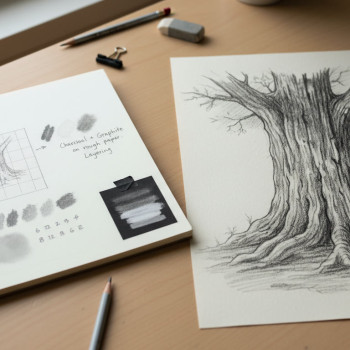Why a Diction → Devices → Meaning Template Works for AP Lit Poetry
Poems are compact—every word and pause does work. If you’ve ever sat in an AP Literature class wondering how to turn a tight, mysterious poem into a confident paragraph (or two), you need a reliable method. The Diction → Devices → Meaning template gives you a repeatable, exam-friendly path from the poet’s language to your interpretive claim.
This approach reduces analysis panic. Instead of chasing every possible interpretation, you follow the poem’s clues: what words the poet chooses (diction), how those words are shaped (devices), and what those choices mean in a larger sense (meaning). It’s practical, defensible, and fits neatly into timed essays and oral discussions.

How the Template Maps to AP Exam Tasks
AP Lit rubrics reward textual evidence and coherent claims. The template aligns directly with those demands:
- Diction → points to specific words or phrases you can quote as evidence.
- Devices → let you name and explain techniques (metaphor, enjambment, caesura, etc.)—this shows you can read craft.
- Meaning → ties evidence and craft to an interpretive claim, demonstrating insight and control.
Follow this order in your paragraphs: present the line(s) you’re analyzing, identify diction choices, explain the device(s) used, and conclude with the larger meaning. It’s a logical story of how language builds meaning.
Step-by-Step Template: From First Read to Polished Paragraph
1) First Read: Get the Feel
Read the poem straight through once for tone and overall movement. Don’t annotate yet—just notice whether the poem feels clipped, mournful, playful, bitter, etc. That gut impression will anchor later choices.
2) Second Read: Underline and Label
On your second pass, underline striking words and phrases. Circle any repeated words and mark shifts in tone or person. Ask short, surgical questions in the margins: Why this verb? Why this break? Why this image?
3) Choose One Strong Claim
Pick a single, defendable claim per paragraph or essay that answers: What is the poem doing? Keep it manageable. Instead of “The poem is about life,” try “The poem resists consolation by contrasting domestic images with violent verbs.”
4) Build the Paragraph Using Diction → Devices → Meaning
Structure your paragraph like this:
- Topic sentence: state the small claim (what this section of the poem does).
- Evidence: quote specific diction (1–2 short phrases or a line).
- Devices: name the technique(s) shaping that diction (imagery, syntax, sound, form).
- Explanation: link how the device + diction produces the effect you claimed.
- Mini-conclusion: connect to the overall poem’s meaning or tone.
Repeat for a second paragraph focusing on another moment in the poem. Finish with a short conclusion that connects your two paragraphs and restates how the poet achieves the poem’s central move.
Common Diction Categories to Flag Immediately
Poets don’t use words at random. Flag these categories during annotation—then you’ll have evidence ready when you write.
- Concrete Nouns: tactile objects (glass, river, throat) often anchor imagery.
- Strong Verbs: verbs control action and tension (shatter vs. break).
- Elevated vs. Colloquial Language: shifts can signal voice or irony.
- Jargon or Historical Terms: can situate poem culturally or thematically.
- Repetition and Anaphora: repeaters signal emphasis or obsession.
Devices: The Tools Poets Use to Shape Meaning
Once you’ve locked in diction, ask how form and craft shape those words. Here are device families and quick ways to discuss them in your essay.
- Sound Devices: alliteration, assonance, consonance, rhyme—describe how sound amplifies mood or focus.
- Syntax and Lineation: enjambment, caesura, and sentence breaks—explain how pauses or runs change emphasis.
- Imagery and Metaphor: literal vs. figurative language—show how an image reframes meaning.
- Structure and Form: sonnet, free verse, stanza breaks—connect form to argument or emotional arc.
- Tone and Voice: first vs. third person, ironic distance—relate voice to reliability and perspective.
Quick Device Labels to Use in Essays
- Strategic repetition
- Juxtaposed imagery
- Controlling metaphor
- Shifting syntax
- Acoustic foregrounding
Putting It Together: A Model Paragraph
Below is a template you can adapt under timed conditions. Replace bracketed notes with specifics from the poem.
Topic sentence: In the poem’s second stanza, the speaker narrows the scene to [concrete image], using [class of diction] to undercut any simple comfort. Evidence: For example, the line “[quote phrase]” places the blunt noun/verb “[word]” next to [contrasting word or image]. Devices: This pairing functions through [device—metaphor, enjambment, alliteration], so that [explain how the technique shapes the reading]. Explanation: By foregrounding this language, the poet turns what might be a domestic image into a site of [conflict/irony/mortality], suggesting that [meaning tied to claim]. Mini-conclusion: Thus, the stanza reframes the speaker’s memory from [initial tone] to [resulting tone], which supports the poem’s larger move to [broader claim].
Mini-Exercise: Annotate a Short Passage
Practice is the key. Try this exercise on any 8–12 line poem or an excerpt from a longer poem:
- Circle the most attention-grabbing five words.
- Label one sound device and one syntactic choice.
- Write a 50–70 word claim connecting those choices to a meaning.
This drill trains the muscle you’ll use on exam day: fast evidence selection, device identification, and a concise interpretive claim.
How a Table Can Help You Plan Under Time Pressure
Use a simple three-column table during practice to organize your evidence quickly. On exam day, your notes don’t have to be polished—just functional.
| Poem Line / Passage | Diction / Quotation | Device → Meaning (Two short phrases) |
|---|---|---|
| Stanza 1, lines 1–3 | “cold iron,” “white window” | Concrete nouns + contrast → domestic image feels alien; suggests estrangement |
| Stanza 2, line 7 | “shattered” | Violent verb + enjambment → sudden rupture; breaks narrative comfort |
| Closing couplet | Repetition of “if” | Modal repetition → uncertainty / unresolved desire |
Example Walkthrough (Applied to a Hypothetical Excerpt)
Let’s imagine a short excerpt where a speaker calls a family kitchen “a shuttered cathedral” and describes hands “that trembled like small birds.” Here’s how to use the template quickly:
- Diction: note the surprising noun choices—“cathedral” (grand, sacred) and “small birds” (fragile, animate).
- Device: this is a controlling metaphor and simile juxtaposed—religious grandeur vs. delicate life.
- Meaning: the metaphors compress contradiction—home is both revered and brittle; reverence coexists with vulnerability.
Now write one paragraph: state that the poet uses grand and fragile images to argue that memory sanctifies ordinary spaces while exposing their fragility. Quote the two phrases, name metaphor and simile, explain the tension, and tie it to the poem’s implied elegy or preservation theme.
Timing and Structure Tips for the AP Exam
Time management is everything. Here’s a realistic plan for a free-response poetry question:
- 2–3 minutes: quick read for tone and overall sense.
- 6–8 minutes: annotate—underline diction, label devices, choose two moments to analyze.
- 20–25 minutes: write two focused paragraphs using Diction → Devices → Meaning and a short intro/conclusion.
- 2–3 minutes: concise revision—check evidence and transitions.
This schedule leaves room for evidence-rich paragraphs while ensuring you finish with time to polish. If you consistently practice this pacing, timelines become second nature.
What Examiners Want to See
- Precise textual evidence—short quotes integrated into your prose.
- Named devices—don’t dodge craft vocabulary when appropriate.
- Clear connections from detail to claim—explain how craft produces meaning.
- Coherent and controlled writing—clarity wins over ornate but vague language.
Common Mistakes and How to Fix Them
Mistake: Vague Claims
Fix: Replace vague verbs (shows, reveals) with specific outcomes (complicates, denies consolation, eroticizes memory). Tie the claim to a mechanism.
Mistake: Overquoting
Fix: Use short, focused quotations—1–4 words or a short phrase. Integrate them into your sentence so the evidence supports your interpretation instead of replacing it.
Mistake: Device-Listing Without Explanation
Fix: If you name a device, follow it immediately with how it functions in that line—don’t leave the reader guessing why the device matters.
Practice Plan: 4 Weeks to Sharper Poetry Skills
Consistent, targeted practice beats cramming. Here’s an achievable four-week plan you can adapt to your schedule.
- Week 1 — Foundations: Annotate 3–4 short poems. Focus only on diction identification and one device each.
- Week 2 — Devices Bootcamp: For each poem, write one paragraph emphasizing a single device and its meaning.
- Week 3 — Timed Practice: Do 2 timed drills per week using the 30-minute structure described above.
- Week 4 — Synthesis: Take full practice prompts and write complete responses, then revise based on rubric criteria.
If you want personalized pacing, Sparkl’s personalized tutoring can help you design daily micro-drills and offer 1-on-1 feedback—tailored study plans and expert tutors speed up skill acquisition with targeted correction and AI-driven insights to track progress.
Rubric-Driven Revision Checklist
Before you submit any timed essay, use this quick checklist (60–90 seconds):
- Do I have a clear thesis or controlling idea?
- Are there at least two pieces of textual evidence integrated into the response?
- Did I name and explain devices used in the evidence?
- Have I connected device + diction to an interpretive meaning?
- Is the writing coherent—no major grammar issues or clumsy sentence structure?
How to Turn Practice into Performance
Practice with purpose. That means simulating test conditions and then doing deliberate review: annotate the parts you missed, recast weak paragraphs using the Diction → Devices → Meaning structure, and maintain a log of recurring weaknesses (vague claims, weak evidence, misused device names).
1-on-1 coaching is especially effective here: a tutor can point out persistent blind spots in real time and model high-scoring paragraph construction. A service like Sparkl’s personalized tutoring pairs expert tutors with measurable progress plans and AI-driven insights so you get focused feedback on exactly what to improve.
Putting the Template to Music: A Short Example Paragraph
Below is a concise model paragraph you could write for a typical AP prompt. (This is a structural example—adapt to the prompt and poem you’re given.)
In the poem’s final stanza, the speaker’s diction compresses tenderness and threat, transforming memory into an unresolved pledge. The phrase “white knives” places a domestic color word next to a violent noun, and the following line’s caesura isolates “and I forgive / myself” into a hesitant afterbeat. This juxtaposition—an intimate color paired with a hostile object, and a sudden pause before a claimed absolution—works through metaphor and syntactic interruption to show that forgiveness in this poem is fragile and pressured, not cleanly resolved. Ultimately, the poet suggests that personal reconciliation is a fractured achievement, always shadowed by what remains unspoken.
Beyond the Exam: Why This Template Builds Literary Judgment
Learning to move from diction to device to meaning trains habits you’ll use beyond AP scores: careful attention to word choice, awareness of craft, and the discipline to tie observation to interpretation. Those skills matter in college seminars, writing workshops, and any thoughtful reading of literature.
Final Thoughts and a Short Checklist for Tomorrow’s Practice
Start small—ten minutes of focused annotation a day beats occasional marathon sessions. Use the Diction → Devices → Meaning template until it feels natural. Time yourself, get used to quoting short phrases, and practice naming devices precisely. If you want extra accountability, a few sessions of personalized tutoring—especially with structured feedback and a tailored study plan—can accelerate this process markedly. Sparkl’s approach, which combines 1-on-1 guidance with progress tracking, is designed to do exactly that for students who need compact, targeted improvement.

With this template in your toolkit, poems stop feeling like riddles and start feeling like arguments you can read, support, and explain. Keep the method simple: find the diction that catches your eye, ask which device the poet uses to shape it, and then answer what that combination means in the poem’s larger movement. Practice that sequence, and the AP Lit poem prompt goes from intimidating to manageable—and even, sometimes, exhilarating.
Good luck, and happy close reading.


















No Comments
Leave a comment Cancel